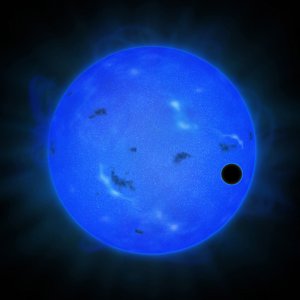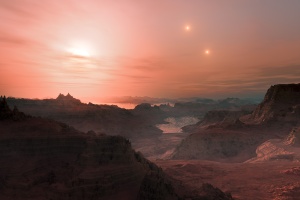In the final paragraph of my last blog, Life Lies in Orbits and Atmospheres, I mentioned the recent analysis of Super-Earth Gliese 1214b and the low mass star it orbits, Gliese 667C. My own disclosure of information regarding this star and its planet was rather brief. Considering the new information about habitability in this star system, it is only fitting I expound on this topic.
Our solar system has three planets in the habitable zone: Venus, Mars, and Earth. There may be extremophile life outside the habitable zone on the Galilean moons of Jupiter or on Saturn’s moon, Titon. According to modern scientific discovery, life only exists on Earth and may have existed in the past on Venus or Mars. Unlike our solar system, Gliese 667C is one star in a three star system. Seven planets orbit Gliese 667C and it was believed that only one planet orbited in Gliese 1214b’s habitable zone. But, a cooperative of astronomers from around the world recently discovered another two planets in the habitable zone of Gliese 667C. These three planets are SuperEarth’s, giant terrestrial planets four to five times the mass of Earth. They do not possess any super qualities nor are they the breeding ground for super heroes, as neither of these hypotheses has yet been confirmed.

Gliese 1214b.
http://www.sci-news.com/astronomy/science-super-earth-gliese-1214b-water-rich-atmosphere-01360.html
What is super is the recent discovery that Gliese 1214b, one of the trio, is surrounded by “a water rich or hydrogen dominated atmosphere with extensive clouds.” It would not be super if the atmosphere was composed primarily of hydrogen because it would create conditions inhibitive to the survival of life, much like Earth’s very early atmosphere. Fortunately, upon further spectroscopic evaluation of the atmosphere -to supplement previousRayleigh Effect analysis- scientists believe that it is more likely a water dominated atmosphere. This presence of water vapor allows scientists to accurately approximate how and where the planet formed in its solar system.
Also, and more intriguingly, because water vapor is a Greenhouse Gas it could foster a Greenhouse Effect sufficient enough to maintain a warm surface temperature. Warm surface and atmospheric temperatures are conducive for liquid water to form. Even though we still need much more evidence to scientifically prove that liquid water exists on Gliese 1214b, the thought tantalizes. If scientists confirm the presence of water vapor, it means oxygen exists there, which is a necessary element for the formation of life.
Most of this is personal speculation and optimism. For now, I am free to speculate about the habitability of this beautiful blue SuperEarth. Even if liquid water is not present on this SuperEarth, the possibility for solar systems similar to the low mass Gliese 667C system is extremely high because 80% of stars in the Milky Way are low mass stars. This fact makes me ponder not whether other worlds have liquid water, but how many worlds have liquid water.

Artist’s rendering of possible sunset in the Gliese solar system. Notice the three stars.
http://www.google.com/imgres?imgurl=&imgrefurl=http%3A%2F%2Fen.wikipedia.org%2Fwiki%2FGliese_667&h=0&w=0&sz=1&tbnid=kP6LUhl5L0QskM&tbnh=183&tbnw=275&zoom=1&docid=O2bvvspOrpaxAM&ei=mMxMUq6pLqemygGD84HwBQ&ved=0CAEQsCU
Sources
“A SuperEarth With a Water-Rich Atmosphere.” Astrobiology Magazine. Helen Matsos, 6 Sept. 2013. Web. 30 Sept. 2013. <http://www.astrobio.net/pressrelease/5665/a-superearth-with-a-water-rich-atmosphere>.
“One Star, Three Habitable Planets.” Astrobiology Magazine. Helen Matsos, 26 June 2013. Web. 30 Sept. 2013. <http://www.astrobio.net/pressrelease/5533/one-star-three-habitable-planets>.
